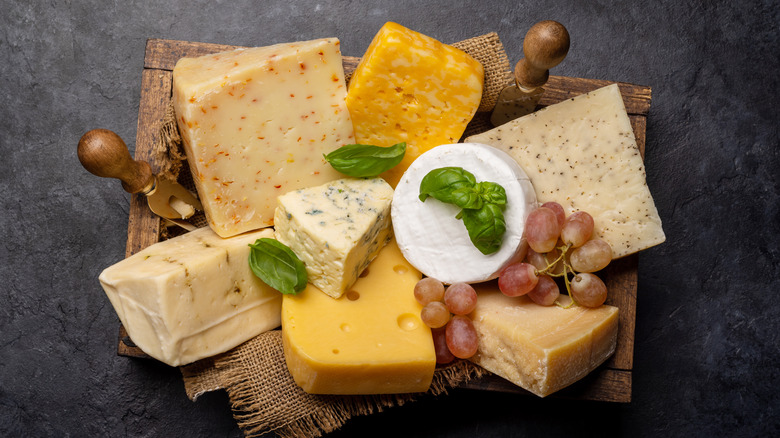A Look At Wisconsin's Deep History With Cheese
Certain American states have profound associations with one particular food. Idaho potatoes are well-known across the country, Maryland is crab-crazy, and Maine lobster is so iconic there's an international festival for it. But there may not be a greater association between a state and its food than Wisconsin and cheese. The Badger State is so good at its chosen area of expertise that you don't need to look any further than Wisconsin for a top of the line cheese board. Heck, Wisconsin's other and probably more popular nickname is "America's Dairyland."
But how did Wisconsin become so closely associated with cheese in the first place? In part, it started because the state sat on the edge of America's first frontier, drawing immigrants from all over Europe, and cheese kept better than other dairy products. From there, though, it grew into the massive cheesemaking culture we know now, with over 35,000 dairy farms operating in Wisconsin today.
Wisconsin owes its cheese history to immigrants
It seems strange now to think of a time when the great American frontier was the Midwest, but in the late 18th and early 19th centuries, that was absolutely the case. Known as the Old Northwest, the area comprising modern-day Ohio, Indiana, Illinois, Michigan, Wisconsin, and part of Minnesota went through numerous territorial incarnations before it reached its final form, but what all of them had in common was broadcasting a siren call for immigrants to the North American continent who wanted to carve out their own path away from already-established states. As all immigrants do, these westward travelers brought their own food practices with them — and many of these practices included cheese. Lots and lots of cheese.
The really fascinating thing was, it wasn't just one ethnic group of immigrants bringing cheese with them. French immigrants brought blues and bries, Italians brought gorgonzola and mozzarella, English newcomers brought cheddar, the Dutch brought gouda, Scandinavians brought havarti, Germans brought muenster, the Swiss brought ... well, Swiss — it really was a cheese free-for-all. This helps explain how today, Wisconsin is famous not simply for one type of cheese, but for pretty much all of them.
The Wisconsin cheese industry grew rapidly
Wisconsin didn't officially become a state until 1848, but its history with cheese was already well-underway by then thanks to this immigrant influx. Though the state was initially better-known for wheat production, farmers rapidly switched to dairy, as the land was particularly good for cattle grazing. With such a huge surplus of milk, meanwhile, people had to find ways to keep it from spoiling, and cheese was the answer.
The first commercial cheese farm in Wisconsin was either that of Charles Rockwell near Fort Atkinson in 1837 or Anne Pickett near Lake Mills in 1841, but within a half-century, cheese was everywhere in Wisconsin. Though New York was still the nation's top cheese producer by the turn of the 20th century, Wisconsin overtook the Empire State in 1910 and has never looked back. Today, 90% of the milk produced in Wisconsin is used for cheesemaking, and 90% of what's ultimately produced is sold away from Wisconsin. Wisconsin takes its cheese seriously — and so does the rest of the world, considering the state is the only place away from Europe where someone can become certified as a master cheesemaker.


